Manuscript accepted on :July 11, 2017
Published online on: --
Plagiarism Check: Yes
S. L .D. V. Ramana Murty Kadali1, M. C. Das2, R. Vijayaraghavan3 and M. Vijay Kumar4
1Department of Research, Saveetha University, Chennai.
2Department of Pharmacology, NRI Medical College, Guntur, AP.
3Department of Research, Saveetha University, Chennai.
4Department of Pharmaceutical Chemistry, NGSM Institute of Pharmaceutical Science, Deralakatte, Mangalore.
Corresponding Author E-mail: murtypharma@gmail.com
DOI : https://dx.doi.org/10.13005/bpj/1239
Abstract
Toevaluate antidiabetic activity of Chloroxylon swietenia in STZ induced diabetes in albino rats Forty two albino rats were randomly divided into seven groups (n=6). Diabetes was induced by intraperitoneal injection of streptozotocin (60mg/Kg). Distilled water, Tween 80, glibenclamide, Chloroxylon swieteniaaqueous extract(CSAE), ethanolic extracts (CSEE) of 200 and 400mg/kg were given orally for 14 days to the normal control, diabetic control, standard group and test groups respectively. Glucose, TC (total cholesterol), TG (triglyceride), HDL (High density lipoprotein), AST (aspartate aminotransferase), ALT (alanine aminotransferase), ALP (alkaline phosphatase), creatinine, direct bilirubin and indirect bilirubinlevels were estimated. ANOVA followed by Student-Newman-Keuls test was used to analyze the data. CSAE of 200mg/kg showed a significantreduction in glucose, ALT, TB and ALP levels in diabetic rats.CSAE of 400mg/kg showed a significant decrease in glucose, AST, ALT, TB, DB and ALP levels in diabetic rats.CSEE of 200mg/kg showed a significant decrease in glucose, ALT, TB,ALPandcreatininelevels in diabetic rats.CSEE of 400mg/kg showed a significant decrease in glucose, AST, ALT, TB, DB and ALP levels in diabetic rats. Both extracts show antidiabetic activity in STZ induced diabetes.
Keywords
Antidiabetic activity; AST; ALT; ALP;Chloroxylon swietenia; creatinine and Bilirubin streptozotocin;
Download this article as:| Copy the following to cite this article: Kadali S. L .D. V. R. M, Das M. C, Vijayaraghavan R, Kumar M. V. Evaluation of Antidiabetic Activity of Aqueous and Ethanolic Extracts of Leaves of Chloroxylon Swietenia in Streptozotocin (Stz) Induced Diabetes in Albino Rats. Biomed Pharmacol J 2017;10(3). |
| Copy the following to cite this URL: Kadali S. L .D. V. R. M, Das M. C, Vijayaraghavan R, Kumar M. V. Evaluation of Antidiabetic Activity of Aqueous and Ethanolic Extracts of Leaves of Chloroxylon Swietenia in Streptozotocin (Stz) Induced Diabetes in Albino Rats. Biomed Pharmacol J 2017;10(3). Available from: http://biomedpharmajournal.org/?p=16242 |
Introduction
Diabetes mellitus is an endocrine, metabolic disorders caused by relative or an absolute lack of insulin.1According to International Diabetes Federation (IDF), worldwide 382 million people were affected by diabetesin 2013 and it is expected to raise to 592 million by 2035. IDF estimates 65 million diabetic patientsin India in 2013and it is expected to cross 109 million by 2030.2In India diabetic patients are increasing day by daymay be because of the change in food pattern, i.e. fast food diet intake and change in lifestyle.3Management of diabetes is a tough task. The medicines used in diabetic treatment are either too costlier or have adverseeffectslike hypoglycemic coma, insulin resistance, hypersensitivity and metallic taste etc.4 Hence, in the recent years, herbal compoundsare gaining popularity in both developed and developing countries because of their natural origin, low adverse effects.5Ethnobotanical information indicates that around 800 medicinal plants having hypoglycemic or antidiabetic potential.6 Herbal plants are abundant in India.Hence the search for safer and effective antidiabetic agents has become the current research area.5
An ethnobotanicalstudy was carried on the medicinal plants often used for the management of diabetes in Warangal district, Andhra Pradesh by traditional healers.Chloroxylon swieteniais the one of the plant used by the traditional healers for diabetes.7,8Even though medicinal plants are widely used, the effective treatment of the disease has not been verified with scientific standards. Only a few plants usedfor diabetesin traditional medicineare scientifically audited in vivo.9Chloroxylon swietenia belongs to the Rutaceae family. Common name – satinwood, Telugu name – billu, bildu,billedu, Tamil name- porasu orvaaimaram.Chloroxylon swietenia has been reported to have anti-inflammatory activity,10 mosquitocidal activity,11-13 antioxidant activity,14 analgesic activity,14 anthelmintic activity15,antimicrobial activity.15-17Antidiabetic activity was reported with this plant, but with different parts of stem, bark and whole plant.18,19Invitro antidiabetic activity was reported with the leaf extract of Chloroxylon swietenia in our previous report.20Based on the claims and available evidence, it was thought worthwhile to investigate Chloroxylon swietenia for diabetes in animal models.
Materials and Methods
Plant Material and Extract Preparation
The leaves of Chloroxylon swietenia were collected locally and authenticated by Dr. Shiva Kumari, Department of Botany, Andhra Loyola College.After shade-dried (Temp<40°C.), plant material was grounded into a moderately coarse powder. The aqueous extract was made by maceration and the ethanolic extract was made by using soxhlet apparatus. The extract was allowed to dry. The dried extract was weighed. The % yield of each plant extract was calculated. The % of yield obtained was 8.96 and 9.16% for alcoholic and aqueous extracts respectively. Both the extracts were preserved in the refrigerator till further use.
Experimental Design
Both sexes of albino rats weighing 250-300g were used. Rats werefedwith a standard pellet diet and water ad libitum. Animals were kept in a controlled environment (12 h/12 h light/night) and temperature (27±2°C).Before starting the experiment, rats were allowed to acclimatize to the laboratory conditions. All the animal experiments were approved by the institutional animal ethics committee(36/IAEC/NRIMC/2013-14) in accordance with the guidelines of the Committee for the Purpose of Control and Supervision of Experimentation on Animals.
Induction of Diabetes
STZ was freshly prepared by dissolving in citrate buffer (0.01M, PH-4.5) and kept on ice prior to practice. The overnight fasted rats were made diabetes with a single intraperitoneal injection of STZ (60 mg/kg). After 4hrs STZ administration 5% glucose was administered orally in drinking water for a day to overcome the early hypoglycemic phase.Rats were allowed to stabilize for three days.On the third day (72hrs)blood samples were drawn to estimate the blood glucose concentration to confirm the development of diabetes.Rats with plasma glucose above 250 mg/dL were considered as diabetic and used in the study.Both the test extracts and standard drug treatment were given orally for 14days. Blood was collected by the retro-orbitalpuncture under light ether anesthesia on 1, 7 & 14th day of treatment schedule for biochemical estimations.
Rats were randomly allocated into 7groups (n=6) (Table-1).
Table 1: Grouping of animals
| Sl.No | Groups | Type of control | Dose |
| 1. | Normal rats | Normal control (Non-diabetic) | Distilled water |
| 2. | STZ induced Diabetic rats | Diabetic control | Tween 80 |
| 3. | Diabetic rats + Glibenclamide | Standard | 10 mg/kg |
| 4. | Diabetic rats + CSAE1 | Test | 200 mg/kg |
| 5. | Diabetic rats + CSAE 2 | Test | 400 mg/kg |
| 6. | Diabetic rats + CSEE1 | Test | 200 mg/kg |
| 7. | Diabetic rats + CSEE 2 | Test | 400 mg/kg |
CSAE = Chloroxylon swietenia aqueous extract, CSEE = Chloroxylon swietenia Ethanolic extract
Biochemical Estimations
Serum was used to estimate the biochemical parameters like ALP,AST, ALT, TB, DB, creatinine, TG, HDL and TC using commercially available kits.LDL and VLDL values were calculated by using Friedewald’s formula21 as mentioned below
VLDL= TG/5
LDL= TC-HDL-VLDL
Atherogenic index (AI) values were calculated by using formula as given below22
AI= (TC-HDL) /HDL
Statistical Analysis
The data were expressed as mean ± standard error (SE). The Significance of differences among the groups were assessed by using ANOVA, followed by Student-Newman-Keuls test. p<0.05 (5%) were considered as significant.
Results
Effect on Blood Glucose
The effect of extracts on glucose level is illustrated in Graph-1. Statistical analysis at ‘0’ (zero) dayby One-way ANOVA revealed that there was no significant (P>0.05) difference among the groups. Further, statistical analysis on the 7thday of medication showed a significant (P<0.05) difference among the groups. There was a significant elevation of blood glucose level in diabetic control as compared to normal control rats.Student-Newman-Keulstest revealed that glibenclamide, CSAE1, CSAE2, CSEE1 and CSEE2treated groups shows asignificant reduction in blood glucose level as compared to the diabetic control. Similarly, statistical analysis at 14thday showed that there was significant (P<0.05) difference among the groups. Student-Newman-Keuls test revealed that glibenclamide, CSAE1, CSAE2, CSEE1 and CSEE2treated groups shows asignificant reduction in blood glucose level as compared to the diabetic control. Further analysis by ANOVA followed by Student-Newman-Keuls test revealed that glibenclamide, CSAE1, CSEE1 and CSEE2treated groups shows no significant difference between the groups when test groups are compared with standard (glibenclamide) control. This result indicates that test groups produced the effect almost equal to the standard group.
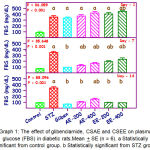 |
Graph 1: The effect of glibenclamide, CSAE and CSEE on plasma glucose (FBS) in diabetic rats.Mean + SE (n = 6). a Statistically significant from control group. b Statistically significant from STZ group.
|
Effect on AST and ALT
The changes in the AST and ALT levels of all the groups are illustrated in Graph-4. Statistical analysis by One-way ANOVA revealed that there was asignificant difference among the groups [p<0.05].There was a significant elevation of AST and ALT level in diabetic control as compared to normal control rats. Glibenclamide, CSAE1, CSAE2, CSEE1 and CSEE2treated groups show asignificant reduction in ALT level as compared to the diabetic control. CSAE1 and CSEE1reduced the AST level when compared to the diabetic control, butthe reduction is not statistically significant (p>0.05). Both the extracts of 400mg/kg dose shows significant(p<0.05) reduction in the AST levels.
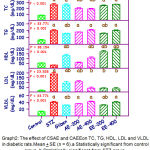 |
Graph 2: The effect of CSAE and CAEEon TC, TG, HDL, LDL and VLDL in diabetic rats.Mean + SE (n = 6).a Statistically significant from control group. b Statistically significant from STZ group.
|
Effect on Total Bilirubin and Direct Bilirubin
The changes in the total bilirubin and direct bilirubin levels of all the groups are illustrated in Graph-5.There was a significant elevation of total bilirubin and direct bilirubin levels in diabetic control as compared to normal control rats.CSAE1, CSAE2, CSEE1 and CSEE2 treated groups shows asignificant reduction in the total bilirubin level as compared to the diabetic control. CSEE of 400mg/kg dose shows the significant reduction inthe direct bilirubin level when compared to the diabetic control.
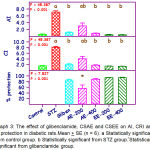 |
Graph 3: The effect of glibenclamide, CSAE and CSEE on AI, CRI and % protection in diabetic rats.Mean + SE (n = 6). a Statistically significant from control group. b Statistically significant from STZ group.*Statistically significant from glibenclamide group.
|
Effect on ALP and Creatinine
ALP and creatinine levels are significantly elevated in diabetic controls as compared to the normal control (Graph-4 and 5). Both extracts of all the doses significantly reduced the elevated ALP levels. CSEE of 200mg/kg showed asignificant decrease in the creatinine levels.
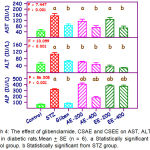 |
Graph 4: The effect of glibenclamide, CSAE and CSEE on AST, ALT and ALP in diabetic rats.Mean + SE (n = 6). a Statistically significant from control group. b Statistically significant from STZ group.
|
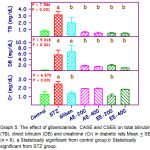 |
Graph 5: The effect of glibenclamide, CASE and CSEE on total bilirubin (TB), direct bilirubin (DB) and creatinine (Cr) in diabetic rats.Mean + SE (n = 6). a Statistically significant from control group.b Statistically significant from STZ group.
|
Effect on Lipid Profile
There was a significant rise in TC, TG, VLDL and LDL levels in the diabetic control in comparison to the normal rats(Graphs-6). Both doses of CSAE showed asignificant reduction in TC level. CSEE of 200mg/kg showed a significant reduction in the TG levels. CSAE (400mg/kg), CSEE(200mg/kg) and CSEE(400mg/kg) showed a significant elevation of HDL levels in comparison to the normal and diabetic control. Both extracts of all the doses significantly reduced the LDL levels in comparison to diabetic control.
AI and CRI values are significantly higher in diabetic control compared to the normal rats (Graphs-2). Standard drug and test extracts significantly reduce the AI and CRI values. Glibenclamide, CSAE1, CSAE2, CSEE1 and CSEE2 showed 86.5, 64.6, 89.3,94 and 94.5 % protection respectively (Graphs-3).
Discussion
The development of safer medicines for diabetes is still a challenge for researchers working in this area.23The experimental data on herbal medication can offer new functional leads to reduce toxicity, time and money are the three main hurdles in drug development. It is correctly stated that ‘laboratories to clinics’ becomes ’clinics to laboratories’ is a true reverse pharmacology approach. 24The development of modern treatment methods requires animal models that mimic the range of pathophysiological changes visualized in diabetic humans. 23
Streptozotocin is commonly using chemical to induce diabetes in rodents than the other chemical inducing agents like alloxan, gold thioglucose etc because of its less toxicity and specificity.25Streptozotocin (2-deoxy-2-(3-(methyl-3- nitrosoureido)-D-glucopyranose) is obtained from Streptomycetes achromogenesand is used to induce both type-1 and type-2 diabetes.STZ is taken up by pancreatic β-cells via glucose transporter GLUT2. STZ alkylates the DNA leads to the β-cell death. STZ is a nitric oxide (NO) donor and this NO destroys the pancreatic islet cells.26
Both doses of CSAE and CSEE significantly decreased the glucose level as compared to the diabetic control rats. This effect may be due the decrease in glucose absorption from the intestines or induction of glycogenic process along with decrease in glyconeogenesis and glycogenolysis.27
Dyslipidemia is a most common complication observed in chemical induced diabetes and presents a serious risk of vascular disease.6 Inthe present study, raise in TC and TG levels were observed in diabetic control rats.In diabetes the abnormal high levels of lipids are due to, an increase in the mobilization of free fatty acids from fat deposits due to the less utilization of glucose.3 Hypertriglyceridemia is amost common abnormality in diabetes.27
The serum lipid levels are generally high in diabetes; mapping a major risk factor for coronary heart disease.6 Excess levels of TC and LDL are major coronary risk factors. The C. swietenia leaf extractreduced the TC, TG and LDL levels, where as it increased the cardioprotective lipid HDL levels significantly. It has been proved that raise in HDL levels is associated with a reduction in coronary risk.28In the present study, it has been observed that the C. swietenia leaf extract mitigated the raised TC and LDL levels in diabetic rats. Further, it has been indicated that TG itself is independently linked to coronary heart disease29and in the present study, the plant extracts lowered TG levels in diabetic rats. The atherogenic index and the coronary risk index were very high in the diabetic rats.28Standard drug and plant extracts significantly reduced the AI, CRI as to the normalrats. % protection was increased with the dose, CSEE has shown more protection than the CSAE.
Diabetes is one of the common causes for a liver disease which includes abnormal liver enzymes, cirrhosis, hepatocellular carcinoma and acute liver failure.The AST, ALT, ALP , TB, and DB levels were raised in lever injury.27 These enzymes are considered as asensitive indicator of liver injury.Chloroxylonswietenia leaf extracts reduced the AST level, it shows the protective effect on theliver. The rise in ALP levels,indicates bone disease, bile tract obstruction or liver disease. C. swieteniaextracts lowered the ALP levels, suggesting its protective effect on liver function.
Diabetes affects the kidney, result in the development of diabetic nephropathy. Serum creatinine levels reveal the kidney function.30CSEE (200mg/kg) significantly reduced the creatinine levels.
Conclusion
It is evident that C. swietenia leafextracts contain antihyperglycemic agents capable of reducing the blood glucose level.
Acknowledgement
The authors are thankful to the colleagues and management for facilitating to accomplish this project.
Conflicts of Interest
None.
References
- Seshiah V. Classification and diagnosis of diabetes mellitus. A handbook on diabetes mellitus, 7th New Delhi and Chennai: All India publishers and distributors. 2016;16.
- IDF Diabetes Atlas. 6th Ed. Belgium: International Diabetes Federation. 2013.
- Manickam D., Periyasamy L. Antidiabetic effect of methanolic extract of Decalepis hamiltonii root in normal and alloxan induced diabetic rats. Journal of pharmacy research. 2013;16(6):166-72.
CrossRef - Nyunai A. B. N.,Njikama N., Abdennebic E. L. H.,TanyiMbaford J., Lamnaouerc D. Hypoglycemic and antihyperglycaemic activity of Ageratum conyzoidesin rats.Afr J Trad CAM. 2009;6(2):123–30.
- Patil A. A., Koli A. S., Darshana A., Patil B., Narayane C. V., Phatak V. A. A. Evaluation of effect of aqueous slurry of Curculigo orchioides aertn. rhizome in streptozotocin induced diabetic rats. Journal of pharmacy research. 2013;7:747-53.
CrossRef - Lanjhiyana S., Garabadu D., Ahirwar D., Bigoniya P., Rana A. C., Patra K. C et al. Hypoglycemic activity studies on root extracts of Murrayakoenigiiroot in Alloxan-induced diabetic rats. J Nat Prod Plant Resour. 2011;1(2):91-104.
- naina V., Estarimamidala. An ethanobotanical study of plants used for the treatment of diabetes in the Warangal district, Andhra Pradesh, India. Biolife. 2013;1(1):24-28.
- Sandhya S., Kumar P. S., Vinod K. R., Banji D., Kumar K. Plants as Potent Anti diabetic and wound healing agents- A review. Hygeia J D Med. 2011;3(1):11-19.
- Attanayake A. P., Jayatilaka K. A. P. W., Pathirana C., Mudduwa L. K. B. Acute hypoglycemic and antihyperglycemic effects of ten Sri Lankan medicinal plant extracts in healthy and streptozotocin induced diabetic rats. Int J Diabetes Dev Ctries. 2015;35:177-83.
CrossRef - Kumar K., Ganesh M., Baskar S., Srinivasan K., Kanagasabai R., Sambathkumar R et al. Evaluation of Anti-inflammatory activity and toxicity studies of Chloroxylon swietenia in Rats. Anc Sci Life 2006;3:33-43.
- Nayak J. B. Comparative study of Chloroxylon swietenia leaf and bark against Culex quinquefasciatus mosquito larvae. International Journal of Multidisciplinary Research and Development 2014;1(1):69-71.
- Kiran S. R., Bhavani K., Devi P. S., Rao B. R. R., Reddy K. J. Composition and larvicidal activity of leaves and stem essential oils of Chloroxylon swietenia DC against Aedes aegypti and Anopheles stephensi. Bioresource Technology. 2006;97:2481–84.
CrossRef - Kiran S. R., Pillay S. V., Reddy K. J. Studies on mosquito larvicidal activity of Chloroxylon swietenia. Journal of pharmacognosy. 2012;3(2):123-25.
- Deb N. K., Dash G. K. A Review on Ethnopharmacolgy, Phytochemistry and Bioactivity of Chloroxylon swietenia DC. International Journal of Emerging Trends in Pharmaceutical Sciences 2013;1(1):11-20.
- Harwansh R. K., Pareta S. K., Patra K. C., Jangde R. Screening of Chloroxylon swietenia dc root for antibacterial and anthelmintic activities. Pharmacologyonline. 2011;1:544-52.
- Prabakaran R., Arivoli S., Hema A., Kamatchi C. Isolation and characterization of flavonoids from Chloroxylon swietenia. J Chem Pharm Res. 2011;3(3):805-13.
- Ramadevi D. Anti microbial activity on leaf extract of Chloroxylon swietenia. JGTPS. 2014;5(3):1940-42.
- Jayaprasad B., Sharavanan P. S., Sivaraj R. Antidiabetic effect of Chloroxylon swieteniabark extracts on streptozotocin induced diabetic rats. Beni-suefuniversity. journal of basic and applied sciences. 2016;5:61–69.
- Patchimatla A., Kankanala S. R., Bandaru S. S., Kulindaivelu U., Jupally V. R. Eggadi Investigation of lipid profile and ocular oxidative stress of Chloroxylon swietenia on streptozotocin-nicotinamide induced diabetic rats.Int J Green Pharm. 2014;8:90-96.
CrossRef - Ramana Murty Kadali S. L. D. V., Das M. C., Vijayaraghavan R., Shanmukha I. In vitro evaluation of antidiabetic activity of aqueous and ethanolic leaves extracts of Chloroxylonswietenia. Natl J Physiol Pharm Pharmacol. 2017;7(5):486-490.
- Friedewald W., Levy R and Fredrickson D. Estimation of the concentration of low density lipoprotein cholesterol in plasma without use of preparative ultracentrifuge. Clin Chem. 1972; 18(6):499-502.
- Santoshkumar J., Manjunath S.,Pranavkumar M. S. A study of anti-hyperlipidemia, hypolipedimic and anti-atherogenic activity of fruit of emblicaofficinalis (amla) in high fat fed albino Rats. Int J Med Res Health Sci. 2013;2(1):70-77.
- Banagar A. V., Shivakumar B., Jayaveera K. N. Effect of Xylia dolabriformisleaves extract on high fructose diet induced C57BL/6J ob/ob diabetic mice. Int J Pharm Sci Res. 2013;4(10):4032-45.
- Kumar A. B. P., Sharma D. E. A., Varshney C. P.,Rao C. V. Antidiabetogenic and antioxidant effects of Caralluma attenuata extract on streptozotocin induced diabetes in rats. Journal of pharmacy research. 2013;7:257-62.
CrossRef - EmamA M. Comparative evaluation of antidiabetic activity of Rosmarinus officinalis L. and Chamomile recutitain streptozotocin induced diabetic rats. Agric Biol J N Am. 2012;3(6):247-52.
CrossRef - Szkudelski T. The Mechanism of Alloxan and Streptozotocin Action in B Cells of the Rat Pancreas. Physiol Res. 2001;50:536-46.
- Yadav K. S. A., Yadav N. P. A., Shanker B. K., Thomas C. A. S., Srivastav A. S., Srivastava S Aet al. Assessment of antidiabetic potential of Cissampelospareira leaf extract in streptozotocin nicotinamide induced diabetic mice. Journal of pharmacy research. 2013;6:874-78.
CrossRef - Thirumalaisamy B., Prabhakaran G. S., Marimuthu K., Chatterjee T. K. Antihyperlipidemicactivity of the ethyl-acetatefraction of Stereospermum Suaveolens in streptozotocin-induced diabetic rats. Journal of Pharmacopuncture. 2013;16(3):023-29.
CrossRef - Mohana lakshmi S., kumar A. S., Srikanth S., Vidyulatha K. T., Jyothi G., Mounicachoudari D et al. Anti-Diabetic and antihyperlipidemic activity of Ficus krishnae in alloxan induced diabetic rats. International Journal of Preclinical and Pharmaceutical Research. 2010;1(1):14-18.
- Wehash F. E., Abo-Ghanema I. I., Saleh R. M. Some physiological effects of Momordica charantia and Trigonella foenum-graecumextracts in diabetic rats as compared with Cidophage®. World Academy of Science Engineering and Technology. 2012;64:1206-14.







